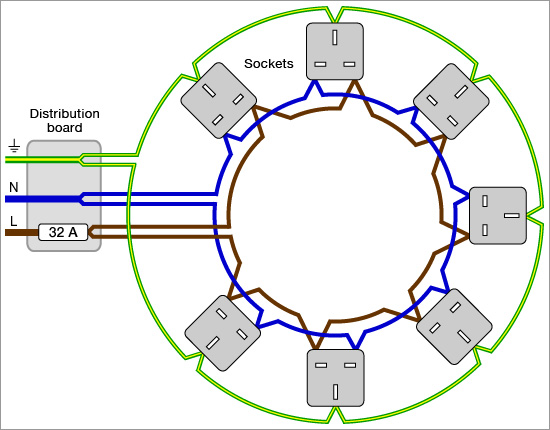The power points in an electrical installation are called socket
outlets. These socket outlets commonly called plug points are wired in
two ways. These are the ring circuit wiring and the radial circuit
wiring.
Ring Circuit Wiring
A ring circuit commences from the consumer unit or distribution board
through an MCB or fuse of specific rating usually 30 Amps and loops into
each socket outlet and returns to the same MCB or fuse in the consumer
unit or distribution board. Looping of the ring circuit wires must be
done for the live conductor, neutral conductor and the protective
conductor in separate rings. The ring method of connection is done only
for the 13 Amps socket outlets, as the individual 13Amps plugs are
separately having fuses. A ring circuit may have an unlimited number of
socket outlets provided that the floor area served by the ring does not
exceed 100 square meters and that the maximum demand of the circuit does
not exceed the MCB or fuse rating. A kitchen should usually have a
separate ring circuit.
Radial Circuit Wiring
A Radial circuit commences from the consumer unit/distribution board
through an MCB/fuse of specific rating e.g. 20Amps, loops into each
socket outlet but ends at a socket outlet and does not return to the
original fuse/MCB at the consumer unit or distribution board.
Credit : https://www.electricalengineeringtoolbox.com/2017/01/how-to-wire-socket-outlets-in-domestic.html
Radial and Ring circuits
different domestic wiring techniques
| Radial circuit wiring |

| In a radial circuit power is
transmitted from point to point by a single length of cable linking each point to the next. It starts at the main fuse box and terminates at the last connected device. Intermediate junction boxes may connect individual sockets or chains of several sockets, but there is never a loop wiring structure. Worldwide, radial wiring is by far the most commonly used technique. |
| Ring circuit wiring |

A ring circuit provides two independent conductors for line, neutral and protective earth for each connected socket (see scheme above).
If the load is evenly split across the two directions the amperage in each direction is half of the total, allowing the use of wire with half the current-carrying capacity.
Ring circuit wiring offered a more efficient and lower cost system which would safely support a greater number of sockets. The lower costs aspect was related to fact that wires with a smaller diameter could be used, compared to radial wiring.
Ring circuits provide low protection against overcurrents. Ring circuits usually supply a large number of sockets, and have to be protected with high-rated overcurrent circuit breakers (typically 32 A). To minimize safety risks - ring circuits can deliver more current than appliance flexible power cords can handle - each plug requires a fuse, rated to protect the flexible cord attached to the plug.
A detailed report about advantages, disadvantages and history of BS 1363 13A plugs and ring circuits, written by D.W.M. Latimer FIEE can be downloaded from http://www.theiet.org/resources/wiring-regulations/ringcir.cfm?type=zip




No comments:
Post a Comment